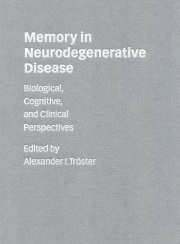Book contents
- Frontmatter
- Contents
- List of contributors
- Preface
- PART I Biological perspectives
- PART II Cognitive perspectives
- PART III Clinical perspectives
- 14 Biological and psychosocial risk factors for dementia and memory loss
- 15 Cross-cultural issues in the neuropsychological assessment of neurodegenerative disease
- 16 Psychometric issues in the clinical assessment of memory in aging and neurodegenerative disease
- 17 The role of memory assessment in the preclinical detection of dementia
- 18 Clinical differentiation of memory disorders in neurodegenerative disease
- 19 The impact of depression on memory in neurodegenerative disease
- 20 Preserved cognitive skills in neurodegenerative disease
- 21 Drug treatment of cognitive impairment in neurodegenerative disease: rationale, current experience and expectations for the future
- 22 Surgical interventions in neurodegenerative disease: impact on memory and cognition
- 23 Memory dysfunction in neurodegenerative disease: ethical and legal issues
- 24 Memory in neurodegenerative disease: clinical perspectives
- Index
17 - The role of memory assessment in the preclinical detection of dementia
from PART III - Clinical perspectives
Published online by Cambridge University Press: 23 November 2009
- Frontmatter
- Contents
- List of contributors
- Preface
- PART I Biological perspectives
- PART II Cognitive perspectives
- PART III Clinical perspectives
- 14 Biological and psychosocial risk factors for dementia and memory loss
- 15 Cross-cultural issues in the neuropsychological assessment of neurodegenerative disease
- 16 Psychometric issues in the clinical assessment of memory in aging and neurodegenerative disease
- 17 The role of memory assessment in the preclinical detection of dementia
- 18 Clinical differentiation of memory disorders in neurodegenerative disease
- 19 The impact of depression on memory in neurodegenerative disease
- 20 Preserved cognitive skills in neurodegenerative disease
- 21 Drug treatment of cognitive impairment in neurodegenerative disease: rationale, current experience and expectations for the future
- 22 Surgical interventions in neurodegenerative disease: impact on memory and cognition
- 23 Memory dysfunction in neurodegenerative disease: ethical and legal issues
- 24 Memory in neurodegenerative disease: clinical perspectives
- Index
Summary
INTRODUCTION
As the baby boom generation approaches retirement age and average life expectancy continues to rise, dementia will become an increasingly prevalent syndrome (Manton 1990; Myers 1990; Chapter 14). For example, estimates in the USA project that Alzheimer's disease (AD) will increase from its current level of approximately 4 million to more than 14 million affected individuals over the next 50 years (Khachaturian et al. 1994). Thus, neuropsychological research on dementia has increasingly focused on identifying the pattern, progression and neuropathological correlates of the cognitive deficits associated with various dementing disorders (La Rue 1992; Poon et al. 1992). These efforts have led to an increased understanding of the particular neuropsychological deficits that occur in the early stages of dementia. Furthermore, investigators have recently begun to identify cognitive changes that appear to presage the development of dementia. These recent advances in research on the neuropsychological detection of preclinical dementia, and their potential clinical implications, will be discussed in the present chapter.
PRECLINICAL DETECTION OF ALZHEIMER'S DISEASE
To date, the available epidemiological and biological evidence suggest a view of AD as a chronic disease, and the emerging picture is that of a long preclinical period of neuropathological changes prior to the appearance of the full dementia syndrome (for a discussion, see Katzman and Kawas 1994). Many of the recent attempts to identify cognitive markers of incipient AD are also consistent with the view of AD as a chronic disease.
- Type
- Chapter
- Information
- Memory in Neurodegenerative DiseaseBiological, Cognitive, and Clinical Perspectives, pp. 278 - 289Publisher: Cambridge University PressPrint publication year: 1998
- 2
- Cited by

